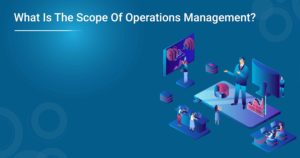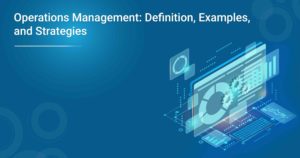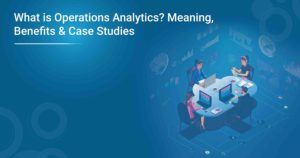In an age that is fast moving towards automation in every sector, companies cannot hope to survive without updating their IT environment. Every firm depends on this technology for many of its operations. Everything depends on how well-equipped the organisation is with modern technology, from managing the internet to gathering data for analytics. Various hardware and software applications must be managed and kept updated for a firm to function efficiently. This is why IT operations management is crucial for every company’s growth and development.
Understanding IT Operations Management
Every organisation needs an IT infrastructure comprising hardware, software, applications, network, website and storage solutions. It requires people familiar with this technology to set up and manage the IT infrastructure in a firm. IT operations management is the function of managing IT set-up in a firm and ensuring that it remains updated. Companies need a set of business managers, programmers and system administrators to ensure that the department always functions without any break or failure. Any failure in the system can result in the disruption of operations in the company.
A detailed understanding of the process is possible by enrolling in the Advanced Certificate Course In Operations, Supply Chain and Project Management. Visiting our website can teach you more about this course and how it will enable you to do your job better.
What Comes Under IT Operations Management?
IT operations management is concerned with computers, software, cloud, networking, etc., that companies require for their internal operations, productivity and customer support. This department is tasked with making decisions regarding software platforms, hardware systems, cloud providers, and the qualified people required to manage them in large companies. These managers also form teams to create custom software programs for the company. They also administer the data centre facilities that are highly important in modern days when analytics is crucial for a company’s success.
IT operations management, or ITOM as they are commonly called, are also responsible for various other functions. They must ensure that the IT infrastructure in the company is secure as more cases of breaches are being reported from around the globe. The team must also make sure that OS upgrades are done as and when required. ITOM is also responsible for software licensing and renewal. They must also see that adequate training is given to the IT staff members to keep them updated with the latest developments.
Functions Of ITops
- IT Infrastructure / Network Operations
IT operations management is responsible for maintaining all the equipment and software required to provide internal and external communication, data storage, data management and security. The tasks under these are:
- To ensure the functioning of all networking devices needed for communication.
- Manage internal telephone and VoIP systems.
- Authorising users, managing access control and providing access to remote users.
- Manage communication both within and outside the organisation.
- Management of ports for safe outside server access.
- Ensuring network security and regulating traffic using firewalls.
- Checking for issues related to networking and resolving them.
- IT Support And Help Desk Management
ITOM is responsible for providing tech support and managing the help desk. Their tasks include service calls, ticketing, troubleshooting and request fulfilment. IT operations management also includes ensuring backup and conveying messages regarding outages. They are also responsible for managing licences and user accounts. Disaster recovery also comes under their responsibility. Their tasks include:
- Data centre and facility management
- Management of help desk and network operations.
- Allocate user accounts.
- Conducting audits and testing.
- Manage backups.
- Ensuring maximum uptime and maintaining the stability of the network.
- Making plans for disaster recovery and ensuring the continuance of the business.
- Device And Server Management
IT operations management is also tasked with maintaining the devices and servers in the organisation.
- Maintaining and upgrading servers and cloud-based infrastructure.
- Managing storage and network.
- Setting up emails and authorising accounts.
- Making provisions for devices allocated to users.
- Ensuring that company applications have access to necessary hardware.
ITOM Best Practices
Move Away From Ad Hoc Management
Gone are the days when companies could have an IT management that fixes when something is not working. It is essential to move away from such a system to one that prevents any disruption from happening. Active monitoring and proactive maintenance must be the first step to managing the IT operations in an organisation.
Also Read: What Is The Scope Of Operations Management?
Get Management Support
IT operations management requires resources like people and devices. These can be purchased only if the top management is convinced about the need for such a function. This is why it is necessary to get the support of the executives for the allocation of funds for the additional resources. When the top brass is with the operations manager it is also easy to bring about a cultural change in the organisation to ensure that everyone follows the systems recommended. It will also take care of resistance from any department.
Evaluate Existing Processes
For effective IT operations management, you must take stock of existing processes and how they are connected with the IT environment and the company’s business goals. The company will need experts with good knowledge of IT operations processes and solutions for mapping the IT environment. If these are not available, it is worth acquiring them to achieve ITOM goals. Based on the enormity and complexity of the IT infrastructure and the available management resources, the mapping process may begin with manually evaluating the environment and processes.
Define The Goals
Any work will be successful only if the goals are clearly defined. It is the same with IT operations management also. Based on the company’s objectives, it is necessary to fix the operations management goals for IT. The manager must give clear directions to those involved in the job. There must also be a detailed plan about how the process is to be executed. When it comes to IT operations, the objectives may start with acquiring necessary applications and services and end with devising methods to save operational costs.
Ways To Deploy The Process
You must also find the correct deployment method based on the chosen management method. For smaller companies, it may be expensive to do the job in-house. The process needs creating an in-house team and acquiring the necessary devices. Alternatively, companies can partner with experts in the field. Service providers will give access to IT experts, hardware and the necessary solutions to make IT operations management easy and economical.
Align With Company Goals
It is often found that IT operations management acts differently from the company’s objectives. This will not give the desired results. Every organisation has its goals for IT and digital transformation initiatives. The ITOM manager must ensure that the management process aligns with the firm’s objectives. It is also necessary to get input from all stakeholders in this matter.
Evaluate Available Data
All ITOM decisions must be based on the data available to the organisation. To ensure this, it is essential to conduct a data audit before choosing any ITOM solution. You must make sure that the available data is accurate, up-to-date, consistent and capable of communicating with the chosen operations process method.
Introduce Automation
Many ordinary tasks are repetitive that must be identified. These can be automated to make the processes consistent. It also helps in avoiding errors that happen due to human intervention. Automating the process will also free experts who can be used for performing more complex and valuable jobs.
Integrate With Other IT Processes
IT operations management must integrate with other IT management functions. This is crucial in the case of IT service management and asset management. If the firm is not using a configuration management database to consolidate IT management data, then it is worth investing in integrating ITOM and IT management.
Now that you have seen the best practices in ITOM, it is time to see how the process benefits organisations. One can learn everything about this process in the Advanced Certificate Course In Operations, Supply Chain and Operations Management. Our website can show you more about the course.
Benefits Of Using IT Operations Management

- Improved Profits
Companies adopting ITOM perform better than those that don’t. This is bound to increase the profitability of the organisation. They also benefit from improved security from breaches. This will ensure that the company doesn’t suffer from external attacks and disruption. Managing your IT operations also ensures that you have an edge over your competitors.
- Better Customer Experience
Customer experience is critical for a company’s success. All organisations are trying their best to keep customers happy and retain them. IT operations management ensures that the connectivity and networking with external elements are good. It will also keep tech-based services like SAAS consistent, giving the clients a better experience. ITOM also allows the business to perform continuously without breaks that can happen if there is a failure in the IT system.
- Reduced Downtime
When you manage your IT operations, there will be less downtime. It means that work will happen faster without any breaks. Customers will be happy that their orders are being fulfilled on time and they get information regarding the same. With proper ITOM, you can make sure that failures are prevented instead of acting on them after they have occurred.
- Reduce Operational Costs
When you use all your systems to their full capacity, there is no need for the purchase of new devices or hardware. Implementing IT operations management will help in using the organisation’s IT infrastructure to the maximum. Proper configuration management will help to get the maximum out of all assets. It will also reduce the decline in performance that occurs in all systems. All these will result in reduced operational costs.
- Improved Employee Productivity
An important reason for the delay in work by employees is that they must depend on the IT department to solve any issues with the system. ITOM helps you maintain an efficient help desk for employees’ issues. This will result in problems getting solved faster and improve employee productivity.
- Better Disaster Recovery
Breaches of IT infrastructure are becoming more and more common. Such events can badly affect your systems and even cause heavy losses to the organisation. In many cases, such incidents cause the failure of the server and sometimes even that of the backup. IT operations management helps to keep data safe and ensure that backups happen periodically.
Also Read: Operations Management: Definition, Examples, and Strategies
Challenges In Implementing IT Operations Management
As cloud-based computing services, virtualisation and IoT occupy important places in an organisation’s regular work, it becomes increasingly difficult to implement ITOM. Let us see the major challenges that companies face.
Disconnect Between Technology And Systems
As the IT infrastructure in a company grows, there is a huge disconnect between the technologies and systems in use. It forces the IT team to use spreadsheets and other manual methods to form a clear idea of the assets that need to be managed. Many organisations have some applications deployed on-premise, some through SaaS and others, through IaaS providers. This adds to the confusion and results in a disconnect between these systems.
Lack Of Visibility Of Assets
IT operations management needs to accomplish two things. They must allocate resources to different departments. The team must also respond quickly to security and operational issues. Both these require complete visibility of the IT assets in the organisation. Companies that are gathering data from software systems’ on-premise architecture don’t offer the visibility that is essential for making decisions on IT spending. With information scattered across systems, the IT team lacks the visibility to achieve business objectives.
Difficulty In Scaling And Securing
As there is very little visibility across disconnected systems and software, it becomes increasingly difficult for companies to introduce new services. It can lead to shadow IT. Such fractured IT infrastructure has poor oversight and hence increased vulnerability to security breaches.
Those aspiring to become operations managers in charge of IT infrastructure can learn a lot about ITOM at the Advanced Certificate Course in Operations, Supply Chain And Project Management from a reputed institution. You can learn more about the course on our website.
Conclusion
The number of benefits an organisation can gain from implementing IT operations management far outweighs the challenges. In a world that is becoming faster and more competitive, companies that don’t manage their IT operations well can end up staying behind their competitors. Such companies also open themselves to more risks and hence all companies need to implement this process and ensure maximum efficiency for their IT infrastructure.
More Information:
11 Common Operations Manager Interview Questions & Ans
Which Functions are Included in IT Operations Management?
What are the functions of production and operations management




























